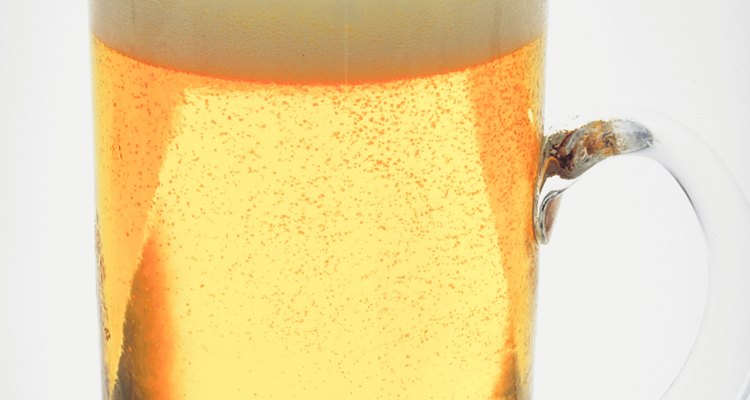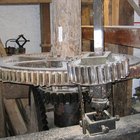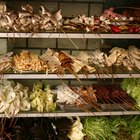
NA/AbleStock.com/Getty Images
Producing a tangy and bitter taste, hop seeds are one of the primary ingredients that give beer its distinctive flavor. Growing in cone-like clusters, the leaves must be stripped from the seed pods before the hops can be incorporated into the brewing process. When processing large volumes of hops, instead of harvesting the seeds traditionally by hand, building a hop harvesting machine will save hours of tedious work.
Lay out two 3-foot wide by 4-foot long sections of 1/4-inch wire mesh. Trim off 1 inch from the length and 6 inches off the width from one of the wire sections with a pair of wire cutters.
Wrap the wire sections into two separate drums, abutting the long ends of the wires sections against each other. Fasten the ends of the wire sections together with cable ties and trim off the ends of the ties with the wire cutters.
Stand the drums on end on a 1/4-inch thick sheet of plywood. Trace the pattern of the end of the drums onto the plywood with a felt-tipped pen.
Cut out the traced circles from the plywood with a jigsaw; cut two more disks of the same size for the opposites ends of the wire drums.
Drill eight evenly spaced holes around the edges of the plywood disks with a 1/4-inch drill bit; place the holes 1/8 inch from the edges of the disks. Drill a hole exactly through the center of each plywood disk with a 1/2-inch drill bit.
Place the base of a 1/2-inch slip-on pipe flange over the center hole in each of the smaller plywood disks. Attach the flange to the disks with wood screws and a screwdriver.
Connect the edges of the smaller disks to the ends of the smaller wire drum with cable ties. Trim off the ends of the ties with the wire cutters.
Run a 1/2-inch diameter by 4 1/2-foot long pipe through the flanges attached to the disks of the smaller drum. Center the drum on the pipe and tighten the retaining nuts on the flanges, to the pipe, with a wrench.
Insert the smaller drum inside the lager drum. Slip the larger plywood disks over the pipe and attach the edges of the disks to the ends of the larger drum with cable ties. Trim the ends of the ties with the cutters.
Drill a single hole through the center of the top horizontal cross member on a pair of sawhorses with a 1/2-inch drill bit, making one hole in each sawhorse. Place one sawhorse at opposite ends of the drums; run the ends of the pipe through the holes in the saw horses, suspending the drums off the ground.
Bolt a drive-belt pulley to one end of the pipe, where the pipe sticks through either of the saw horses, with a wrench. Cut a 2-foot square piece of plywood with the saw. Attach the base of an electric motor to the plywood with wood screws.
Place the motor beneath the drive belt pulley on the pipe. Attach a drive belt to the drive belt pulleys on the pipe and the motor.
Cut a 3-foot long by 1-foot wide access door through the sides of both drums with the wire cutters. Connect one side of each door to each respective drum cage with cable ties spaced at 6-inch intervals, to act as hinges.
Load the smaller inside drum with dry hops. Secure both ends of each the doors on both drums with a piece of string and start the motor. As the drums rotate the hop leaves will protrude through the wire mesh of the interior drum and be pulled from the pods while rubbing against the wire mesh of the exterior drum.
Related Articles

How to Pickle Brine Sausage

How to Make a Flour Mill Machine
How to Cook a Standing Rib Roast on a ...

How to Make Your Own Shoe Tree

How to Cook Lechon
How to Julienne Mint
Things to Do in Martinsville, Virginia

How to Parboil Artichokes

How to Make a Wedding Cascade Bouquet

How to Dry or Freeze Oregano

How to Grill Ground Deer Sausage

How to Freeze Ramps & Wild Leeks

How to Cook Crawfish on the Stove

How to Make Homemade Propane Pig Cookers

Fruits or Vegetables Starting With X
How to Cook Cut Moringa Drumsticks

How to Replace a Vending Machine Lock

How to Make a Nosegay

How to Blanch Cashews

How to Cook Cactus Leaves
References
- Fabrication and Welding Engineering; Roger Timings
- The Metal Craft Book; Janice Kilby and Deborah Morgenthal
Photo Credits
NA/AbleStock.com/Getty Images